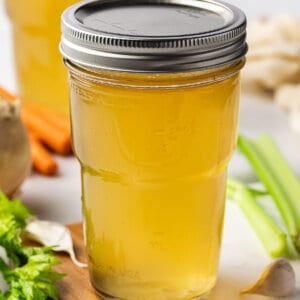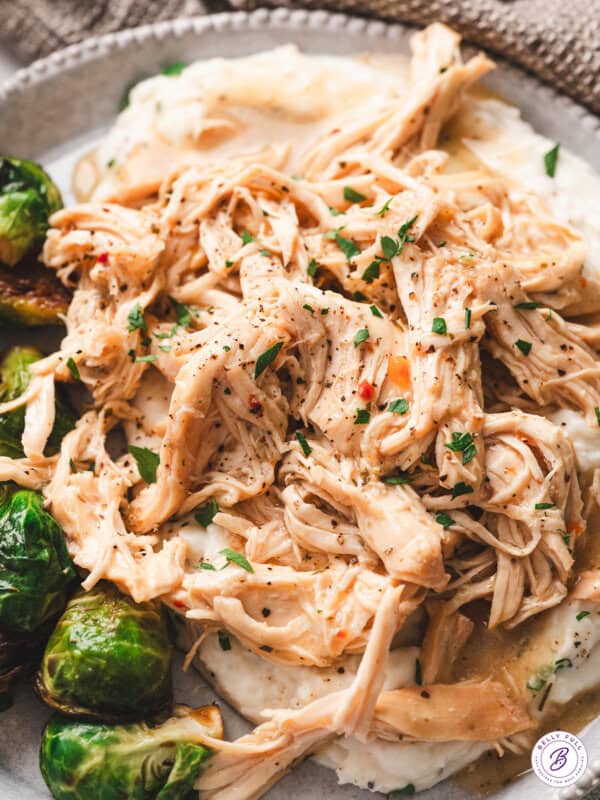Chicken Stock
Published
Published
All you need is leftovers from a whole chicken, veggies, and a few herbs to make this Homemade Chicken Stock. The perfect base for soups and so many other recipes!

Pin this now to find it later
Pin ItThis post may contain affiliate links. If you click on one and make a purchase, we may earn a small commission at no extra cost to you. We only recommend products we genuinely love.
Next time you make my slow cooker whole chicken or buy a rotisserie chicken, make sure to save the bones and scraps! This chicken stock recipe is my favorite way to make sure every part of the whole chicken gets used and it tastes so much better than any store-bought broth or stock. Not to mention that it’s easy to make and customize with whatever you have on hand.
This homemade stock can be used to make so many things, from soups and stews to various chicken dinners. I’ve included many of my favorites below.
What’s The Difference Between Chicken Broth and Stock?
Chicken broth and chicken stock are often used interchangeably but they’re technically not the same. Chicken broth is typically made with the whole chicken while chicken stock is the carcass and water. Both can be customized with whatever herbs and spices you decide to add and you can usually substitute homemade stock for broth in recipes.

What’s in This Homemade Chicken Stock Recipe?
Homemade chicken stock is made with just a few veggies, spices, and herbs. Scroll down to the recipe card below for measurements.
- Water
- Bony chicken pieces – I use the leftover bones and carcass from my slow cooker whole chicken recipe. You could also do the same with a rotisserie chicken.
- Veggies – Onion, celery, and carrot.
- Spices & herbs – Smashed garlic, salt, whole cloves, and a bay leaf season the stock.
Variations
You can easily customize your stock with different herbs and spices, based on your desired flavor. I like to keep it pretty simple so the flavor stays versatile. Some options include rosemary, thyme, Better Than Bouillon, roasted garlic, peppercorns, fennel, cloves, ginger, mushrooms, or dill.

Tips for Success
- Simmer, don’t boil. After you initially bring the stock to a boil, you want to reduce the heat to a gentle simmer – usually medium-low. Do not boil it the whole time. This can cause the fat to separate too much and give the stock a greasy after-taste/texture.
- Go easy on the salt. While you want to give your homemade chicken stock some flavor, don’t go too crazy on the salt. Remember that this will be used in recipes that likely already call for additional salt to be added.
- Use veggie scraps. One great thing about chicken stock is that you can use all parts of the veggies, so you can keep the scraps as you are making up other dishes and use them in this recipe. Or keep a ziploc bag in the freezer of scraps to make this stock.
Ways To Use It
Homemade chicken stock can be used in any number of soup recipes and in place of chicken broth in recipes as well. But don’t limit yourself to just soups. A few of my favorite recipes that call for chicken stock include chicken marsala, lemon chicken orzo soup, and chicken pot pie noodles.
Proper Storage
- Fridge. Chicken stock can be stored in an airtight container for up to 4 days. (Mason jars make great storage vessels!)
- Freezer. You can also freeze broth for up to 3 months in any freezer-safe container. I like to freeze some in ice cube trays for those recipes when I need just a small amount.
I hope you love this delicious and easy recipe – be sure to give it a review below! Also don’t forget to follow Belly Full on TikTok, Facebook, Instagram, Pinterest, and YouTube!
Homemade Chicken Stock

Ingredients
- 6 cups water
- 1 pound bony chicken pieces, (see note)
- 1 large yellow onion, , peeled, ends trimmed, and quartered
- 2 large stalks celery, , cut into 1-inch pieces
- 1 large carrot, , peeled and cut into 1-inch pieces
- 1 clove garlic, , peeled and smashed
- 1 & 1/2 teaspoons salt
- 2 whole cloves
- 1 bay leaf
Instructions
- Add all the ingredients to a large soup pot or Dutch oven. Bring to a boil. Reduce heat to a gentle simmer (medium-low), covered, for approximately 1 & 1/2 hours.
- Strain stock into a large bowl. Discard chicken pieces, vegetables, cloves, and bay leaf. (At this point you can make clarified stock for clear soup, see note below.)
- Skim fat off the surface using a large shallow spoon or, after broth is chilled, skim off solid fat.
- Use as desired.
Notes
Nutrition
Nutritional information given is an automatic calculation and can vary based on the exact products you use and any changes you make to the recipe. If these numbers are very important to you, I would recommend calculating them yourself.









